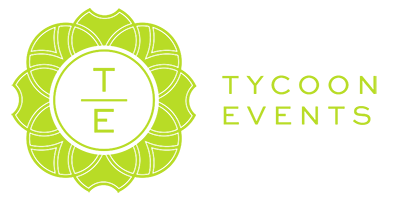In our line of work, we often have clients that come to us with their event date set for a year in advance, 6 months in advance, or 3 months away. The past two years are another story! We often have clients requesting large-scale events to be planned in a matter of weeks. Not ideal but it can be done, especially if you’re a Tycoon!
Here are our tips for planning an event that is in 3 weeks or less:
- Create your team and establish their roles and responsibilities.
It is important to lay out all the things that need to get done in a detailed checklist and who is tasked with seeing them through. That way if something is not done, you know who is accountable for the item. Another element to the success of the checklist is communication. In a tight timeline, copy each other on all relevant emails and use ‘live’ documents, such as Google Docs, so that everyone can update the documents constantly.
- Create a list of your main vendors and who will require a contract, payment made, important dates (final payments due) and more details (floor plans, final numbers etc.).
Here is a list of some vendors you may want to consider booking as soon as possible:- Your venue space
- Your caterer and/or bartenders
- Your audio visual team (if the venue does not provide this service)
- The photographer and/or videographer
- Your graphic designer for all signage or digital needs at the event
- Entertainment of any kind
- The florists, rental companies, or custom décor creators
- Once your most important vendors are lined up, draft an event plan.
Outline the program, just the high level details and timings, food options, and any important details guests need to know about (parking, coat check, dress code). This information will filter into your registration process and guest communications. For any event with food, dietary information is essential to collect at the registration process. Make sure registration closes with enough time before the event to circle back to any guests whose information you’re missing, confirm final numbers with the venue, etc..
- Schedule all pre-event meetings as soon as possible.
Your calendar will quickly get filled with other meetings with vendors, so ensure you have enough time for your committee meetings, client meetings, or other essential event update meetings.
- Do your site visits together.
Including your vendors on site visits allows your experts to point out any flaws in your event design, or additional needs that need to be flagged. By doing it together you also ensure that you are maximizing your and your vendors’ time. This also allows your venue to be aware of the ins and outs of your event in an efficient manner and to know who all of the key players are.
- Establish all critical organizational documents that will be required and set up the templates.
Some of the most important documents our team uses for nearly every event are:- Budget
- Event plan
- Critical path or checklist
- Staffing plan (list of all event roles and the people involved with each role onsite)
- Communication plan (list of all communications sent to attendees before the event and even during the event)
- Graphic design overview (lists all the onsite signage needed at the event)
- Setup plan (lists all the items needed to be setup from staging and lighting, to every table and chair at the registration table)
- Teardown plan (lists all the items that need to be returned to rental companies, thrown away, or donated after the event)
- Minute x minute (extremely important to document all the times vendors are onsite, when speakers are speaking on stage, etc.)
- Production schedule (this is a schedule given to the AV team for complex video, sound and speaking events and includes details about what is on screen, and who is on stage for the entirety of the event)
- Get started early on your graphic design and communications plans.
These are often overlooked, can be the most time consuming, and also require the most lead time. Remember that all signage usually needs 5 business days for printing alone (unless you want an unhappy print vendor on your hands) and the design process can sometimes take several rounds of revisions. Ensure that you are not sending thins to print too early. Last minute sponsors, changes in menu, etc. can result in your signage being incorrect, which can confuse your attendees (unless you have time for reprints).
- Host your pre-event meeting(s) a couple of days before the event.
Host a pre-event meeting for your volunteers, speakers and event team to ensure they are set up for success, have all of the information they need and can ask any questions. Additionally, draft a one-page document that outlines all of the critical information that they should know, i.e. the times each person is needed onsite, if they are provided food, parking details, expectations, dress code, etc.
- Don’t overcomplicate the event.
With events that don’t have a lot of planning lead time, keep it simple. Focus on creating a seamless experience for your attendees and those involved in the event instead of it feeling thrown together without much forethought. And never forget: communication, communication, communication!
– Your Tycoon, Eryne XO
